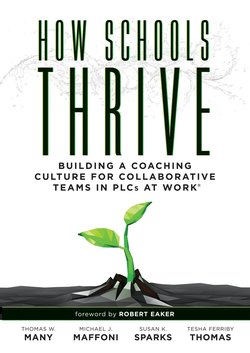Читать книгу How Schools Thrive - Susan K. Sparks - Страница 8
На сайте Литреса книга снята с продажи.
ОглавлениеFOREWORD
By Robert Eaker
It’s no secret; the use of high-performing teams is a powerful way to improve organizational effectiveness—including schools! And the use of collaborative teams isn’t new. As a young Marine recruit at Paris Island, South Carolina, in 1962, I distinctly recall an officer emphasizing that the entire United States Marine Corps was built on one overarching idea: a Marine rifle squad consisting of twelve Marines who work together (interdependently), to accomplish a shared mission (common goals), for which they hold each other accountable for success (mutually accountable). Think about that! The United States Marine Corps understood the power of collaborative teaming in 1962—in fact, long before that!
Since the mid-1950s, the use of high-performing collaborative teams has become so commonplace in organizations of all types, all over the world, that it is not even discussed anymore. There is an exception, however. Sadly, the norm for American education is still one of teacher isolation. In most schools, individual teachers are expected to ensure their students learn more standards than ever before, at higher levels of rigor, and in increasingly adverse conditions. This disconnect between what is known to be “best practice” (collaborative teaming) and what actually occurs (teacher isolation) is one of the great mysteries of modern educational practice.
However, there is good news! The increasing popularity of the Professional Learning Communities at Work® (PLC) framework has resulted in more schools embedding collaborative teaming into district and school structures and cultures. In short, in a high-performing PLC, collaborative teaming is not viewed as an innovation or initiative, or a unique structure to try. Instead, collaborative teams are seen as the engine that drives virtually every aspect of what occurs day in and day out. In PLCs, collaborative teams are the vehicle by which data-driven, research-based best practices are embedded within the daily routines of the district office, schools, teams, individual classrooms, and importantly, the support staff. In a highly effective PLC the use of collaborative teaming has become simply “How things are done around here!”
An important caveat is in order; in and of itself, collaborative teaming will do little, if anything, to improve student learning. Collaborative teaming is a vehicle—a means to an end, not an end in and of itself. Effectiveness—improved student learning—will be determined by the quality of the work being done by teams. Effective teams engage in the right work, in the right ways, at the right times, and for the right reasons!
Engaging teams in the right work will not happen by accident or invitation. If teams are to thrive, they need a number of things such as a rationale (the why for each task, product, or activity), time to meet, training, examples, monitoring, feedback, encouragement, support, along with frequent and timely celebration. In short, teams need to be effectively coached!
It’s not enough to merely recognize that supporting and improving team effectiveness can be accomplished through coaching. The issue is what are concepts, practices, procedures, and tools that educators can use to effectively coach teams? What tools are available to coach coaches? How can coaches get better? In How Schools Thrive, Thomas W. Many, Michael J. Maffoni, Susan K. Sparks, and Tesha Ferriby Thomas present research-based concepts, practices, and protocols that can enhance team effectiveness and are grounded in years of successful practice. The result is a collection of tools that leaders can implement, in a reasonable amount of time, and when taken together and used with fidelity, are proven to be effective.
How can teams and coaches keep “getting better” in a culture that, by its very definition is never ending? The answer, in part, lies in continually drilling deeper into the work, coupled with sharpened specificity. How Schools Thrive moves far beyond how to effectively coach teams in addressing the three big ideas of a PLC (a focus on learning, collaborative teaming, and a focus on results.), or the four critical questions associated with learning (What is essential that all students learn? How will we know if each student is learning—skill by skill? How will we respond as a school and as a team when students struggle with their learning? And, how will we extend the learning of students who demonstrate proficiency?) The authors provide specific suggestions and protocols for drilling deeper into both the structural and cultural aspects of embedding the characteristics of a high-performing PLC into each team—task by task.
Drilling deeper implies, in part, making conscious what is often unconscious. For example, many teams simply evolve (or devolve) into a set routine that is rarely examined. In How Schools Thrive, Many, Maffoni, Sparks, and Thomas provide specific ideas for coaching teams into developing effective routines, tasks, and habits that revolve around such practices and collective inquiry, developing an action orientation that is reflected in action-research, creating a sharp focus on results—improved student learning—all within the framework of continuous improvement.
Of course, it is difficult—if not impossible—to coach a team into enhanced effectiveness unless teams recognize a sense of urgency. Readers of How Schools Thrive will find ideas for collaboratively analyzing data to create an accurate picture of a team’s (or school’s) current reality and pragmatic ideas, practices, and protocols for developing specific plans for moving forward, In short, How Schools Thrive is a resource designed to coach those who coach teams. The bottom line is this: just as improved student learning is inextricably linked to adult learning, adult learning is linked directly to the learning of those whose task it is to help teams improve. Helping teams thrive depends on coaches thriving. The ideas, concepts, practices, protocols, and other resources inside this book are powerful tools for enhancing team performance and ultimately student success. What is more important than that?
